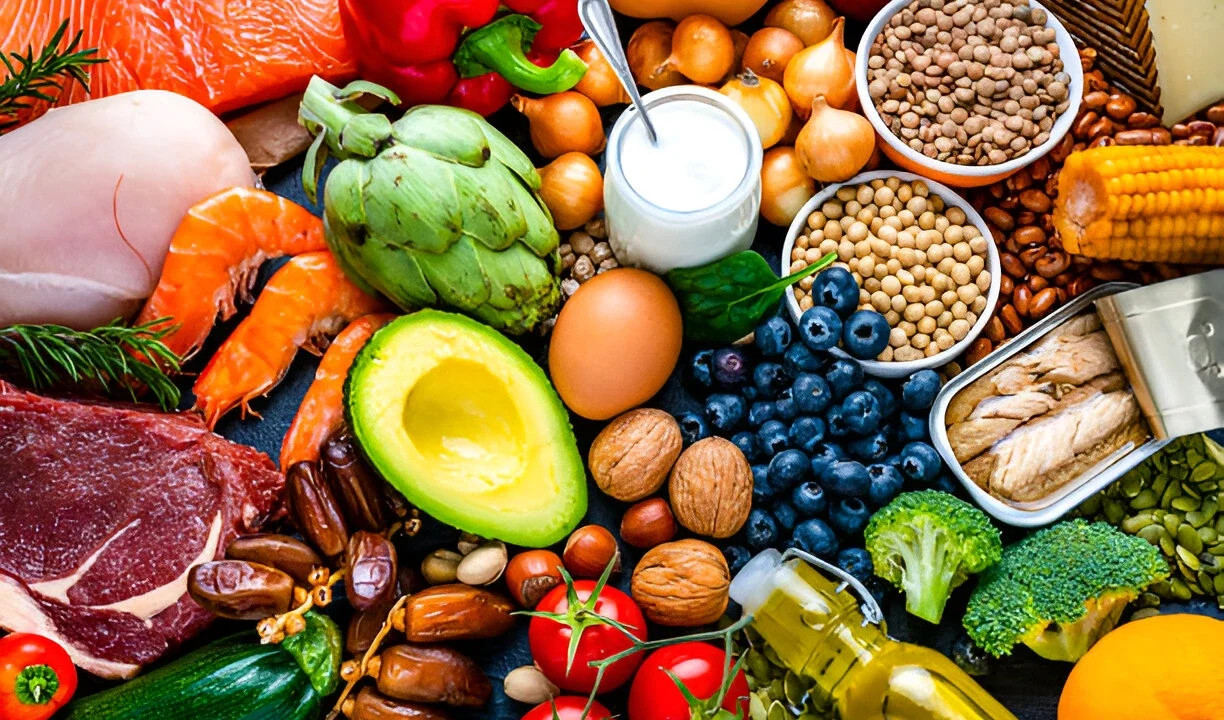
Let’s Talk About Real Food for Real Health
Ever felt confused by all the healthy food buzz out there? One day it’s kale, the next it’s quinoa, and suddenly everyone’s drinking celery juice like it’s liquid gold. Relax — you’re not alone.
The good news? You don’t need a nutrition degree or a fancy meal plan to eat better. Whether you’re trying to shed a few pounds, boost your energy, or feel better in your own skin, understanding healthy food is a solid first step. And guess what? It’s easier than it sounds.
In this blog, we’ll explore what healthy food really means, why it matters, and how you can make simple, smart changes starting today. No guilt-trips, no over-complication — just honest, human advice you can actually use.
What Is Healthy Food, Really?
At its core, healthy food refers to food that’s nutritious, minimally processed, and beneficial for your body. Think fruits, veggies, whole grains, lean proteins, nuts, and seeds. These are foods packed with vitamins, minerals, fiber, and antioxidants — all the good stuff your body craves.
But here’s the twist: healthy food isn’t one-size-fits-all. What’s healthy for one person might not be ideal for another. Someone managing diabetes, for example, will have a different version of “healthy” than someone training for a marathon. And that’s totally okay.
A Quick Breakdown of Healthy Food Categories:
- Whole foods: Fresh fruits, vegetables, whole grains (like brown rice, oats), legumes, and unprocessed meats.
- Superfoods: Foods high in nutrients and antioxidants, such as berries, leafy greens, chia seeds, and salmon.
- Functional foods: These go beyond basic nutrition and may provide additional health benefits, like probiotics in yogurt or omega-3 in flaxseeds.
Why Does Eating Healthy Food Matter?
Your body is an intricate, living machine, and the food you consume is the fuel that powers every single function, from the neurons firing in your brain to the cells regenerating in your skin. Healthy eating isn’t about rigid rules or chasing fleeting diet trends. It’s about respecting your body’s needs, honoring its complexity, and giving it the tools to thrive. Here’s a deep dive into how nourishing choices transform your energy, mood, immunity, and long-term vitality:
1. Boost Your Energy Naturally
Processed foods—like sugary snacks, fried meals, or refined carbs—are like pouring cheap gasoline into a high-performance engine. They create a rapid spike in blood sugar, followed by a crash that leaves you drained, irritable, and reaching for another quick fix. In contrast, whole, nutrient-dense foods act as premium fuel, sustaining your energy levels and keeping your mind sharp.
- Complex Carbohydrates: Think of healthy foods like oats, quinoa, and sweet potatoes as slow-burning logs in a fireplace. They break down gradually, releasing glucose into your bloodstream at a steady pace. This prevents the rollercoaster of energy highs and lows, keeping you focused during work meetings or powering through afternoon workouts without hitting a wall.
- Healthy Fats: Avocados, nuts, seeds, and olive oil aren’t just tasty—they’re essential for cellular health. Fats help your body absorb vitamins (like A, D, E, and K), protect your organs, and keep your brain functioning optimally. A handful of almonds or a drizzle of tahini on roasted veggies can stabilize energy levels for hours.
- Protein Power: Foods like lentils, eggs, and Greek yogurt provide amino acids, the building blocks for muscle repair and enzyme production. Protein slows digestion, preventing blood sugar crashes. For example, swapping a sugary muffin for a hard-boiled egg and sliced avocado keeps hunger at bay and energy consistent.
Imagine a workday where you start with a breakfast of scrambled eggs, spinach, and whole-grain toast. By mid-morning, instead of foggy brain syndrome, you’re tackling tasks with clarity. At lunch, a grilled chicken salad with quinoa and olive oil keeps you satiated, avoiding the 3 p.m. slump. Healthy eating isn’t about deprivation—it’s about feeling unstoppable.
2. Improve Your Mood
Your gut is often called your “second brain,” and for good reason: It produces about 90% of your body’s serotonin, the neurotransmitter responsible for happiness and emotional balance. What you eat directly influences this delicate ecosystem, shaping everything from stress levels to mental resilience.
- Omega-3 Fatty Acids: Found in fatty fish (salmon, mackerel), walnuts, and chia seeds, these fats reduce inflammation in the brain, which is linked to depression and anxiety. Studies show that people with higher omega-3 intake report better emotional stability and cognitive function.
- Leafy Greens: Spinach, kale, and Swiss chard are rich in folate, a B-vitamin that helps produce dopamine and serotonin. Low folate levels are often found in individuals with depression.
- Fermented Healthy Foods: Yogurt, kimchi, and kefir are packed with probiotics—beneficial bacteria that improve gut health. A balanced gut microbiome communicates with the brain via the vagus nerve, reducing stress hormones like cortisol and boosting mood.
A landmark study published in Molecular Psychiatry found that participants who followed a Mediterranean diet (rich in vegetables, fish, nuts, and olive oil) had a 33% lower risk of developing depression compared to those eating processed foods. Even small swaps matter: Dark chocolate (70% cocoa or higher) triggers the release of endorphins, while turmeric’s active compound, curcumin, has been shown to ease symptoms of anxiety.
Pair Nutrition with Body Awareness
While nourishing your gut is key, combining it with mindful movement, like somatic yoga, can amplify mood-boosting benefits. Somatic yoga focuses on deep internal awareness, helping release stored tension in muscles and connective tissue that often contributes to stress or emotional fatigue. Practices like diaphragmatic breathing and gentle, intentional stretches activate the parasympathetic nervous system, further lowering cortisol levels and enhancing the gut-brain connection.
3. Strengthen Your Immune System
Your immune system is your body’s defense force, and every bite you take either equips it for battle or leaves it vulnerable. Nutrient deficiencies weaken this system, making you prone to infections, slow healing, and chronic inflammation.
- Vitamin C: Citrus fruits, bell peppers, and broccoli are loaded with this antioxidant, which stimulates white blood cell production. These cells are your frontline warriors against viruses and bacteria.
- Zinc: Found in pumpkin seeds, lentils, and oysters, zinc shortens the duration of colds and supports wound healing. It’s especially crucial for activating T-cells, which target and destroy infected cells.
- Garlic and Ginger: Garlic contains allicin, a compound with potent antiviral and antibacterial properties. Ginger, with its anti-inflammatory gingerol, soothes sore throats and aids digestion.
Next time you feel a cold coming on, try this immune-boosting tonic:
- Juice of 1 lemon (vitamin C)
- 1-inch grated ginger (anti-inflammatory)
- 1 tsp raw honey (antimicrobial)
- A pinch of cayenne pepper (circulation boost)
Mix with hot water and sip slowly. It’s like a warm hug for your immune system.
4. Support Long-Term Health
Chronic diseases—like heart disease, type 2 diabetes, and certain cancers—are often rooted in years of poor dietary habits. But the inverse is also true: A nutrient-rich diet can be your strongest shield.
- Fiber’s Role: Whole grains, beans, and berries are packed with fiber, which scrubs cholesterol from arteries, regulates blood sugar, and feeds beneficial gut bacteria. Just 30 grams of fiber daily can reduce heart disease risk by 30%.
- Antioxidants: Blueberries, dark chocolate, and green tea contain compounds that neutralize free radicals—unstable molecules that damage DNA and accelerate aging. For example, the resveratrol in red grapes protects blood vessels, while the sulforaphane in broccoli detoxifies carcinogens.
- Plant-Based Power: Diets rich in vegetables, legumes, and nuts are linked to lower inflammation, a key driver of chronic illness. The Adventist Health Study found that vegetarians live an average of 8 years longer than meat-eaters, with significantly lower rates of hypertension and cancer.
Healthy eating isn’t about chasing immortality. It’s about vitality—playing with your kids without getting winded, traveling well into your 70s, or simply enjoying meals without acid reflux or joint pain. Every roasted vegetable, handful of nuts, or grilled fish fillet is an investment in a future where you’re thriving, not just surviving.
The Bottom Line
Eating well isn’t a punishment—it’s empowerment. It’s choosing a vibrant salad over fast food because you want to feel light and energized. It’s blending a smoothie with spinach and mango because your skin deserves to glow. It’s recognizing that every meal is a conversation with your body, and you get to decide whether that conversation is nourishing or neglectful.
Start Small, Think Big:
- Add one extra vegetable to your daily meals (e.g., spinach in scrambled eggs, roasted carrots as a snack).
- Swap soda for sparkling water with a splash of fresh citrus.
- Cook one homemade meal a week using whole ingredients—think stir-fries, soups, or grain bowls.
Your body is a masterpiece. Why not fuel it like one?

Common Healthy Food Myths (Busted!)
There’s a lot of misinformation floating around when it comes to what’s “healthy.” Let’s clear up a few of the biggest myths:
Myth #1: Healthy food is expensive
Truth: While some superfoods carry a hefty price tag, many staples like beans, oats, eggs, and frozen vegetables are budget-friendly and incredibly nutritious.
Myth #2: Eating healthy means giving up flavor
Truth: Herbs, spices, and natural ingredients can make healthy food taste amazing. Ever tried roasted sweet potatoes with cinnamon or avocado toast with chili flakes? Game-changer.
Myth #3: You have to eat perfectly all the time
Truth: Balance is key. Eating healthy foods most of the time is far more sustainable (and enjoyable) than obsessing over every bite.
How to Add More Healthy Food to Your Life — Without Stress?
Ready to make some change, but don’t know where to start? Here are some realistic, low-pressure tips to ease into a more healthful lifestyle:
1. Start With Small Swaps
You don’t need a total kitchen overhaul. Just trade one item at a time:
- White bread ➝ Whole grain bread
- Soda ➝ Sparkling water with lemon
- Potato chips ➝ Air-popped popcorn
2. Cook More Meals at Home
Even just a few times a week can make a difference. You control what goes into your meals — less salt, sugar, and mystery ingredients.
3. Read Food Labels
Keep an eye on added sugars, trans fats, and unpronounceable ingredients. The fewer, the better.
4. Keep Healthy Snacks Handy
Stock up on nuts, yogurt, fruits, and hummus. When hunger hits, you’ll be less tempted to raid the cookie jar.
5. Plan Ahead
Meal prepping on Sundays or having a rough idea of your weekly menu can prevent last-minute unhealthy choices.
Top 10 Must-Try Healthy Foods Right Now
Looking for a place to begin? These power-packed foods are loved by nutritionists and foodies alike:
- Spinach – Full of iron and fiber
- Blueberries – Rich in antioxidants
- Salmon – High in protein and omega-3s
- Avocados – A Great source of healthy fats
- Sweet Potatoes – Loaded with vitamin A
- Greek Yogurt – Probiotic-rich and high in protein
- Almonds – Heart-healthy and crunchy
- Quinoa – A complete plant-based protein
- Oats – Excellent for heart and gut health
- Chia Seeds – Tiny but mighty in nutrients
Making It Work for You: Customizing Healthy Food to Fit Your Lifestyle
Healthy food doesn’t have to look like a picture-perfect salad or a smoothie bowl with 10 toppings. It can be:
- A hearty lentil stew on a cold evening
- A banana and peanut butter before your morning walk
- A veggie-packed stir fry when you’re short on time
Focus on progress, not perfection. Listen to your body. If something makes you feel good and nourishes you, that’s your kind of healthy food.
Your Journey to Better Health Starts with One Bite
Let’s be real: the road to healthy eating isn’t always straight or smooth. And that’s okay. The important part is that you’re trying, and every small step counts.
Healthy food isn’t a diet trend or punishment. It’s a way of showing up for yourself, one delicious, nourishing bite at a time.
So, next time you’re grocery shopping or choosing what to eat, remember this: your body deserves the good stuff. And now, you know exactly where to start.
FAQ Section
Q1. What exactly qualifies as healthy food?
A: Healthy food typically refers to whole, minimally processed foods that provide essential nutrients, like fruits, vegetables, whole grains, lean proteins, and healthy fats.
Q2. Is it expensive to eat healthy?
A: Not necessarily. Many affordable foods — such as beans, lentils, oats, and frozen vegetables — are both nutritious and budget-friendly.
Q3. Can I still eat snacks and desserts if I want to eat healthy?
A: Absolutely! Look for healthier versions of your favorites or enjoy them in moderation. Balance is the key to long-term success.
Q4. Are all processed foods unhealthy?
A: No, not all processed foods are bad. Lightly processed items like canned beans or frozen fruits can still be nutritious and convenient.
Q5. How do I start eating healthy food without feeling overwhelmed?
A: Begin with small changes, like swapping white bread for whole grain or adding one extra veggie to your plate. Over time, these small habits add up.







